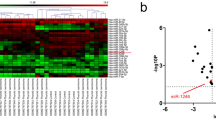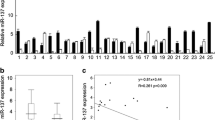Abstract
Thyroid cancer (TC) is most often found in the endocrine system, the incidence of which has been on a continuous increase in recent years. For a better treatment of it, it becomes a pressing matter to further delve into the mechanism of TC onset and progression. FOXP2 is lowly expressed in diverse cancer, which has a deep connection with malignant progression of tumors. However, in TC, studies about this gene are exceedingly limited. In this study, FOXP2 was discovered to be lowly expressed in TC tissues based on the analysis of TCGA database. This finding was further confirmed by the qRT-PCR that FOXP2 was lowly expressed in TC cell lines. The results of a series of cell function assays demonstrated that overexpressed FOXP2 could hamper TC cell proliferation and stemness, facilitate apoptosis, and arrest the cell cycle. For a deep exploration of its mechanism, we mined its upstream factor miR-221-3p with the aid of starBase and mirDIP databases. The dual-luciferase reporter assay was employed to verify the binding relationship between miR-221-3p and FOXP2. Besides, we also discovered the HEDGEHOG pathway existing downstream of FOXP2 by gene set enrichment analysis. Based on these findings, we also performed a rescue experiment, the result of which indicated that the overexpression of FOXP2 was able to reverse the effects of overexpressed miR-221-3p in several cell activities including proliferation, sphere-formation, apoptosis, and cell cycle. Besides, it could also have an impact on the expression of HEDGEHOG pathway-related proteins influenced by overexpressed miR-221-3p. Our study provided the new insights into the mechanism by which miR-221-3p functions in the development of TC.




Similar content being viewed by others
Data Availability
All data generated or analyzed during this study are included in this article.
References
Bray, F., Ferlay, J., Soerjomataram, I., Siegel, R. L., Torre, L. A., & Jemal, A. (2018). Global cancer statistics 2018: GLOBOCAN estimates of incidence and mortality worldwide for 36 cancers in 185 countries. CA: A Cancer Journal for Clinicians, 68, 394–424. https://doi.org/10.3322/caac.21492
Ren, R., Du, Y., Niu, X., & Zang, R. (2021). ZFPM2-AS1 transcriptionally mediated by STAT1 regulates thyroid cancer cell growth, migration and invasion via miR-515-5p/TUSC3. Journal of Cancer, 12, 3393–3406. https://doi.org/10.7150/jca.51437
Jin, M., Lee, W. K., You, M. H., Jang, A., Cheng, S. Y., Kim, W. G., Jeon, M. J., & Lee, Y. M. (2021). SHMT2 expression as a diagnostic and prognostic marker for thyroid cancer. Endocrine Connections, 10, 630–636. https://doi.org/10.1530/EC-21-0135
Wang, L., Huang, Y., Liu, C., Guo, M., Ma, Z., He, J., Wang, A., Sun, X., & Liu, Z. (2021). Deltex3 inhibits epithelial mesenchymal transition in papillary thyroid carcinoma via promoting ubiquitination of XRCC5 to regulate the AKT signal pathway. Journal of Cancer, 12, 860–873. https://doi.org/10.7150/jca.48141
Luo, Q., Guo, F., Fu, Q., & Sui, G. (2021). hsa_circ_0001018 promotes papillary thyroid cancer by facilitating cell survival, invasion, G1/S cell cycle progression, and repressing cell apoptosis via crosstalk with miR-338-3p and SOX4. Molecular Therapy—Nucleic Acids, 24, 591–609. https://doi.org/10.1016/j.omtn.2021.02.023
Hou, X., Shi, X., Zhang, W., Li, D., Hu, L., Yang, J., Zhao, J., Wei, S., Wei, X., Ruan, X., & Zheng, X. (2021). LDHA induces EMT gene transcription and regulates autophagy to promote the metastasis and tumorigenesis of papillary thyroid carcinoma. Cell Death & Disease, 12, 347. https://doi.org/10.1038/s41419-021-03641-8
Wang, J. M., Jiang, J. Y., Zhang, D. L., Du, X., Wu, T., & Du, Z. X. (2021). HYOU1 facilitates proliferation, invasion and glycolysis of papillary thyroid cancer via stabilizing LDHB mRNA. Journal of Cellular and Molecular Medicine, 25, 4814–4825. https://doi.org/10.1111/jcmm.16453
Lai, C. S., Fisher, S. E., Hurst, J. A., Vargha-Khadem, F., & Monaco, A. P. (2001). A forkhead-domain gene is mutated in a severe speech and language disorder. Nature, 413, 519–523. https://doi.org/10.1038/35097076
Chen, M. T., Sun, H. F., Li, L. D., Zhao, Y., Yang, L. P., Gao, S. P., & Jin, W. (2018). Downregulation of FOXP2 promotes breast cancer migration and invasion through TGFbeta/SMAD signaling pathway. Oncology Letters, 15, 8582–8588. https://doi.org/10.3892/ol.2018.8402
Jia, W. Z., Yu, T., An, Q., Yang, H., Zhang, Z., Liu, X., & Xiao, G. (2016). MicroRNA-190 regulates FOXP2 genes in human gastric cancer. Oncotargets and Therapy, 9, 3643–3651. https://doi.org/10.2147/OTT.S103682
Li, Z. Y., et al. (2019). Upregulated microRNA6713p promotes tumor progression by suppressing forkhead box P2 expression in nonsmallcell lung cancer. Molecular Medicine Reports, 20, 3149–3159. https://doi.org/10.3892/mmr.2019.10563
Wu, X. G., et al. (2019). Cancer-derived exosomal miR-221-3p promotes angiogenesis by targeting THBS2 in cervical squamous cell carcinoma. Angiogenesis, 22, 397–410. https://doi.org/10.1007/s10456-019-09665-1
Ma, J., Miao, H., Zhang, H., Ren, J., Qu, S., Da, J., Xu, F., & Zhao, H. (2021). LncRNA GAS5 modulates the progression of non-small cell lung cancer through repressing miR-221-3p and up-regulating IRF2. Diagnostic Pathology, 16, 46. https://doi.org/10.1186/s13000-021-01108-0
Wu, Q., Ren, X., Zhang, Y., Fu, X., Li, Y., Peng, Y., Xiao, Q., Li, T., Ouyang, C., Hu, Y., & Zhang, Y. (2018). MiR-221-3p targets ARF4 and inhibits the proliferation and migration of epithelial ovarian cancer cells. Biochemical and Biophysical Research Communications, 497, 1162–1170. https://doi.org/10.1016/j.bbrc.2017.01.002
Ye, T., Zhong, L., Ye, X., Liu, J., Li, L., & Yi, H. (2021). miR-221-3p and miR-222-3p regulate the SOCS3/STAT3 signaling pathway to downregulate the expression of NIS and reduce radiosensitivity in thyroid cancer. Experimental and Therapeutic Medicine, 21, 652. https://doi.org/10.3892/etm.2021.10084
Xue, F., Li, Q. R., Xu, Y. H., & Zhou, H. B. (2019). MicroRNA-139-3p inhibits the growth and metastasis of ovarian cancer by inhibiting ELAVL1. Oncotargets and Therapy, 12, 8935–8945. https://doi.org/10.2147/OTT.S210739
Shi, L., Yuan, Y., & Li, H. Y. (2019). MicroRNA-139-3p suppresses growth and metastasis of glioblastoma via inhibition of NIN1/RPNI2 binding protein 1 homolog. European Review for Medical and Pharmacological Sciences, 23, 4264–4274. https://doi.org/10.26355/eurrev_201905_17931
Zhu, T., Zheng, J., Zhuo, W., Pan, P., Li, M., Zhang, W., Zhou, H., Gao, Y., Li, X., & Liu, Z. (2021). ETV4 promotes breast cancer cell stemness by activating glycolysis and CXCR4-mediated sonic Hedgehog signaling. Cell Death Discovery, 7, 126. https://doi.org/10.1038/s41420-021-00508-x
Baloch, Z. W., & LiVolsi, V. A. (2018). Special types of thyroid carcinoma. Histopathology, 72, 40–52. https://doi.org/10.1111/his.13348
Cabanillas, M. E., & Habra, M. A. (2016). Lenvatinib: Role in thyroid cancer and other solid tumors. Cancer Treatment Reviews, 42, 47–55. https://doi.org/10.1016/j.ctrv.2015.11.003
Applewhite, M. K., James, B. C., Kaplan, S. P., Angelos, P., Kaplan, E. L., Grogan, R. H., & Aschebrook-Kilfoy, B. (2016). Quality of life in thyroid cancer is similar to that of other cancers with worse survival. World Journal of Surgery, 40, 551–561. https://doi.org/10.1007/s00268-015-3300-5
Wang, Q. S., Kong, P. Z., Li, X. Q., Yang, F., & Feng, Y. M. (2015). FOXF2 deficiency promotes epithelial-mesenchymal transition and metastasis of basal-like breast cancer. Breast Cancer Research, 17, 30. https://doi.org/10.1186/s13058-015-0531-1
Yu, Z., Lin, X., Tian, M., & Chang, W. (2018). microRNA196b promotes cell migration and invasion by targeting FOXP2 in hepatocellular carcinoma. Oncology Reports, 39, 731–738. https://doi.org/10.3892/or.2017.6130
Chen, Z., Xiang, B., Qi, L., Zhu, S., & Li, L. (2020). miR-221-3p promotes hepatocellular carcinogenesis by downregulating O6-methylguanine-DNA methyltransferase. Cancer Biology & Therapy, 21, 915–926. https://doi.org/10.1080/15384047.2020.1806642
Wang, C., Jing, J., Hu, X., Yu, S., Yao, F., Li, Z., & Cheng, L. (2021). Gankyrin activates the hedgehog signalling to drive metastasis in osteosarcoma. Journal of Cellular and Molecular Medicine. https://doi.org/10.1111/jcmm.16576
Pan, Y., Zhou, J., Zhang, W., Yan, L., Lu, M., Dai, Y., Zhou, H., Zhang, S., & Yang, J. (2021). The sonic Hedgehog signaling pathway regulates autophagy and migration in ovarian cancer. Cancer Medicine, 10, 4510–4521. https://doi.org/10.1002/cam4.4018
Zeng, X., & Ju, D. (2018). Hedgehog signaling pathway and autophagy in cancer. International Journal of Molecular Sciences. https://doi.org/10.3390/ijms19082279
Xin, M., Ji, X., De La Cruz, L. K., Thareja, S., & Wang, B. (2018). Strategies to target the Hedgehog signaling pathway for cancer therapy. Medicinal Research Reviews, 38, 870–913. https://doi.org/10.1002/med.21482
Acknowledgements
Not applicable.
Funding
There is no fund for this article.
Author information
Authors and Affiliations
Contributions
Conceptualization: WC. Data curation: QC, WC, HL. Formal analysis: YL, CC. Methodology: QC, HL. Software: YL, CC. Validation: WC, YL. Investigation: HL. Writing—original draft: WC, YL. Writing—review & editing: CC, HL. All the authors read and approved the final manuscript.
Corresponding author
Ethics declarations
Conflict of interest
The authors report no conflict of interest.
Ethical Approval
Our study did not require an ethical board approval because it did not contain human or animal trials.
Additional information
Publisher's Note
Springer Nature remains neutral with regard to jurisdictional claims in published maps and institutional affiliations.
Rights and permissions
About this article
Cite this article
Chang, W., Chang, Q., Lu, H. et al. MiR-221-3p Facilitates Thyroid Cancer Cell Proliferation and Inhibit Apoptosis by Targeting FOXP2 Through Hedgehog Pathway. Mol Biotechnol 64, 919–927 (2022). https://doi.org/10.1007/s12033-022-00473-5
Received:
Accepted:
Published:
Issue Date:
DOI: https://doi.org/10.1007/s12033-022-00473-5




